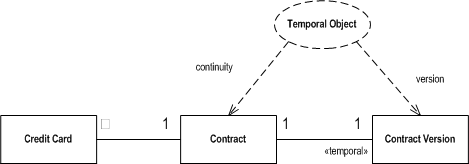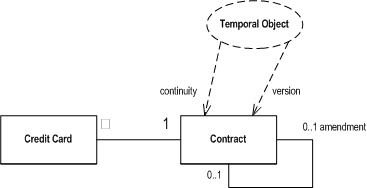Temporal Object
An object that changes over time

07 March 2004
This is part of the Further Enterprise Application Architecture development writing that I was doing in the mid 2000’s. Sadly too many other things have claimed my attention since, so I haven’t had time to work on them further, nor do I see much time in the foreseeable future. As such this material is very much in draft form and I won’t be doing any corrections or updates until I’m able to find time to work on it again.
There are times when you like to think of an object having temporal properties, but others when you think of the object itself as temporal. A good example of this is a contract that goes through a series of amendments. You can think of each amendment as essentially a new contract with new terms, yet you can also think of them as versions of the same contract.
How it Works
This pattern is very common, yet appears in a number of forms. To help grapple with these forms, I find it very helpful to use some role analysis. The pattern essentially has two roles: one continuity and several versions.
Each version captures the state of the object for some period of time. Any time the value of any property of the object changes, you get a new version. Thus you can imagine the versions as a list of objects with an Effectivity to handle the date range.
The continuity represents the on going object that goes through these changes in version. It's the object people refer to when they are thinking of the object throughout its changes.
Other than the temporal property of version, the continuity either has no data or only the data that is truly immutable across the whole life of the continuity. However it acts as the point for other objects to gather data. Current values can be accessed simply with a getting method that delegates to the current version. Historic values can be reached in a couple of ways. Either the continuity can present a temporal property for the properties of the version, or the continuity can provide a snapshot. You can mix both, perhaps providing a temporal property interface for common values and a Snapshotfor the rest.
You might also provide direct access to the versions for editing purposes, if you want users to explicitly change the version history. Often, however, you'll want to control all accesses through the continuity.
The thing that makes this pattern so odd to work with is that you have so many options of how to model this.
Consider a contract I have for a credit card. I get the credit card on Feb 1 1997, and it comes with the usual incomprehensible contract agreement that I file in a filing cabinet never to be seen again. On Apr 15 1998 a revised agreement comes in the post that gets the same treatment. So you have one credit card and two (versions of) contracts.
One way is to treat each contract as effectively a separate contract tied to the credit card. In many ways this doesn't involve Temporal Object at all. Instead you are thinking of explicitly having a credit card with a Temporal Propertyof the contract.

Figure 1: Treating each credit card as a separate contract
A second option is to say that the credit card has a contract which itself has a collection of contract versions. Much of the difference between this and treating each contract as a separate thing is in the way the business views their business process. One advantage is that if a company has customers on different contracts then the contract object is a clear place to hang that concept. Of course a company may have some other concept for this purpose, such as a credit card type (for gold, platinum, and base metal) and only have the one contract per type. In that case the value of the contract object, at least in terms of the representation, is reduced; but there's still value in the behavior.

Figure 2: A contract with explicit versions
Figure 2is the most obvious form of the temporal object pattern as there is an explicit class for both of the roles in the pattern. Things get a little less explicit however when an object plays both continuity and one of the versions.

Figure 3: A contract with amendments - class diagram.
A good example of this is a model like Figure 3 where we have contract that has an amendment which is a contract and thus can have it's own amendments. In this case the contract class plays both the role of continuity and version, with the usual notion that it's only the first contract in the chain that plays the role of continuity. That way anything that referred to the original contract has a clear point of reference, but we can still use versions to hold changes.
The amendment style of Figure 3 is useful when contracts are rarely amended, since that way there is only one contract while the explicit style of Figure 2 always needs at least two objects even if there is no amendment. Despite this, these days I'm inclined to use the explicit form all the time, since the responsibilities are more clearly separated. Also the explicit form is more amenable to using a temporal collection for implementation, and I find that much easier than traversing lists. (Although to be fair you can use a temporal collection for the amendments, rather than the list form that is more usually used.)
Another aspect of this to bear in mind is that often the continuity is not represented by an object, particularly in less OO style systems. For example, in a relational database you may well only have the a table for the versions, and no table for the continuity. In such a relational model, the continuity is implemented by a field such as the contract number. The primary key of the contracts table would combine this contract number and part of the Effectivity, such as the start date.
Another simple example is a source code control system. Here the continuity is the filename of the versioned file, each version is stored, usually as a delta, as a separate entry inside the source code control system.
When to Use It
The biggest question in when to use this pattern is comparing it to using Temporal Property. There's a lot of overlap between the two, indeed you can see that often the continuity's interface is a set of temporal properties. Indeed as far as a client is concerned the interface between having every property be a Temporal Property and using Temporal Object is pretty much the same.
One obvious driver is what proportion of the properties are temporal. If it's just a few, then use Temporal Property, if it's most then use Temporal Object. Of course that just means I'm leaving the judgement of the difference between few and most up to you - isn't that irritating?
Another issue is how the business folks like to see the information. If they want to think of a contact of having explicit amendments, then it's worth using Temporal Object even if only a single property is temporal. As soon as business folks need to refer explicitly to versions, you need Temporal Object to give them versions to refer to.
Further Reading
Anderson's Plop paper discusses this pattern under the name History on Self. [Arnoldi et al] describes this pattern under the name Version History
Example: Explicit Continuity and Version (Java)
For the sample code I'll follow the explicit form of Figure 2. The customer version class contains the data that you would expect with on customers.
class CustomerVersion...
private String address;
private Money creditLimit;
private String phone;
String address() {return address;}
Money creditLimit() {return creditLimit;}
String phone() {return phone;}
void setName(String arg) {_name = arg;}
void setAddress(String arg) {address = arg;}
void setCreditLimit(Money arg) {creditLimit = arg;}
The customer class contains a temporal collection (see Temporal Property for how that works) of customer versions and its simple getting methods delegate to the latest version.
class Customer...
private TemporalCollection history = new SingleTemporalCollection();
public String name() {return current().name();}
public String address() {return current().address();}
public Money creditLimit() {return current().creditLimit();}
public String phone() {return current().phone();}
private CustomerVersion current() {
return (CustomerVersion)history.get();
}
When it comes to updating the customer, you have to consider how explicit you want the versions to be. If all you want is a simple current additive update, you can provide a normal looking setting method. This setting method takes a copy of the version, updates the copy, and then adds the copy to the history.
class Customer...
public void setAddress(String arg) {
CustomerVersion workingCopy = getWorkingCopy();
workingCopy.setAddress(arg);
history.put(workingCopy);
}
public CustomerVersion getWorkingCopy() {
return current().copy();
}
class CustomerVersion...
CustomerVersion copy() {
return new CustomerVersion(_name, address, phone, creditLimit);
}
public CustomerVersion (String name, String address,
String phone, Money creditLimit)
{
super(name);
this.address = address;
this.phone = phone;
this.creditLimit = creditLimit;
}
This allows you to make changes to the temporal record with simple setting methods.
class Tester...
public void testSimple () {
MfDate.setToday(new MfDate (1998, 8, 23));
martin.setAddress(Damon15);
martin.setCreditLimit(Money.dollars(100));
MfDate.setToday(new MfDate (2000, 9,30));
assertAddresses();
assertCreditLimits();
}
private void assertCreditLimits() {
assertEquals(Money.dollars(50), martin.creditLimit(new MfDate(1997, 12, 25)));
assertEquals(Money.dollars(50), martin.creditLimit(new MfDate(1998, 8, 22)));
assertEquals(Money.dollars(100), martin.creditLimit(new MfDate(1998, 8, 23)));
assertEquals(Money.dollars(100), martin.creditLimit());
}
private void assertAddresses() {
assertEquals(Franklin963, martin.address(new MfDate(1997, 12, 25)));
assertEquals(Franklin963, martin.address(new MfDate(1998, 8, 22)));
assertEquals(Damon15, martin.address(new MfDate(1998, 8, 23)));
assertEquals(Damon15, martin.address());
}
However for a retroactive update, the client of customer needs to be aware of the versions. So a retroactive update would be done by a client like this.
class Tester...
public void testWorkingCopy() {
MfDate.setToday(new MfDate (2000, 9,30));
CustomerVersion workingCopy = martin.getWorkingCopy();
workingCopy.setAddress(Damon15);
workingCopy.setCreditLimit(Money.dollars(100));
martin.addVersion(new MfDate (1998, 8, 23), workingCopy);
MfDate.setToday(new MfDate (2000, 9,30));
assertAddresses();
assertCreditLimits();
}

